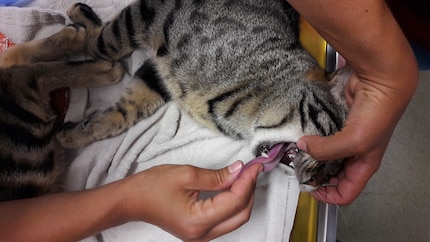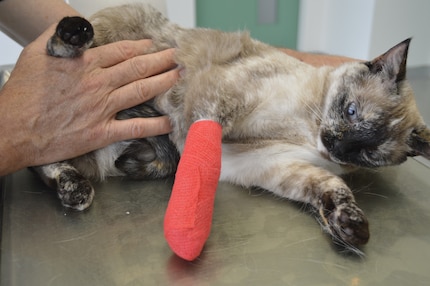
Guide
Do you have these plants at home? Then don't let your pets touch them!
by Darina Schweizer

Every minute counts for pets in distress. Pet owners can provide crucial first aid. Vet and animal rights activist Enrico Clavadetscher explains how it’s done.
Imagine you find a heavily bleeding cat on the side of the road. What do you do? Take it to the vet as fast as you can? This might sound like the obvious thing to do, but it isn’t always the best idea. The animal could lose so much blood on the way that the vet can no longer help it.
Veterinarian and animal rights activist Enrico Clavadetscher has seen this happen time and time again. That’s why he started running first aid courses for dog and cat owners for animal welfare organisation NetAP.
«I want to encourage people. They can often do way more good than they might think, even before heading to the vet’s office. That can make the difference between life and death.»
These are his top tips.

Fire, heat lamps, chemicals or electricity: there are potential burn hazards for pets. This can result in large blisters. «It’s very important to treat these kinds of wounds quickly,» says Enrico Clavadetscher. «Otherwise the inflammation might spread. If more than 40 per cent of the pet’s body surface is affected, it’ll die from the burns.»
The first step you should take according to the vet is holding the wound under lukewarm water. The next first aid measure is to cool it with wet and cold compresses for 15 to 20 minutes. «It’s best to wrap a cooling pad or similar in a clean cloth and hold it gently against the area,» he explains. «The same procedure also helps relieve allergic reactions after insect bites.» If your dog is overheated, he recommends a cool shower or cooling off in a fountain**. After that, it’s time to take the animal to the vet’s.
Poisoning is a bit trickier. This can be caused by certain slug pellets, chocolate or pain killer Ponstan. The drug is dangerous for dogs from as little as two tablets, as they metabolise it much more slowly than humans. «Cats are usually too smart to be poisoned,» says Enrico Clavadetscher. «Plants are also rarely a source of danger. Every now and then a cat poisons itself by eating a mouse contaminated with rat poison. Or it’s put at risk by an uninformed owner who’s administered tick or flea medication intended for dogs.»
First of all, it is important to clear the airways. This means, removing vomit or what’s left over of the harmful substance from the animal’s mouth. You could also try administering a charcoal suspension or tablet made of activated charcoal, which binds toxins in the gastrointestinal tract. Water can also be given to the animal to dilute the poison. If a toxic substance, for example paint, contacts the animal’s skin, it needs to be washed off immediately. «Ideally, you should take the poisonous substance with you to the vet’s practice, so they have more information on the ingredients,» he says.

Vets often deal with bite wounds and paw injuries. They’re usually spotted in dogs, but often go unnoticed in cats, as they tend to withdraw when they’re in pain instead. «Working owners in particular often don’t notice when their pet has a fever. They might think their cat’s just sleeping a little more than usual, when, in fact, blood poisoning has already started,» he says.
It’s important to cut out injuries as quickly as possible using a razor or scissors and to rinse dirt out of the wound with water. «The animal should also be prevented from licking the wound,» the vet adds. «Saliva contains digestive enzymes and bacteria that can make the wound become infected.» It’s best to keep the wound dry, disinfected and bandaged.
Once you’re on your way to the vet’s, you need to take particular care if you’re dealing with a fracture. «Make sure to hold the animal to prevent it from standing on its paws. Otherwise a simple fracture may turn into a complicated one.» To spare your dog or cat more pain and stress, Enrico Clavadetscher recommends administering a painkiller. However, it’s important to know that painkillers for humans shouldn’t be used on animals. Carprofen is recommended for dogs, and Metacam or similar anti-inflammatories for cats without kidney and liver problems (linked pages in German).

Pet owners can do little or nothing if their pet has gastric torsion. This can occur in deep-chested dogs including German shepherds, Great Danes and Dobermanns and similar breeds. What happens is that the stomach rotates around the oesophagus and presses on the blood vessels. This cuts off the blood supply to the stomach and quickly turns into a life-threatening condition. «These are the most critical cases for us vets alongside heart problems,» says Enrico Clavadetscher. A twisted stomach requires an immediate operation carried out by a vet to save the animal’s life.
In most situations, dog and cat owners can already do a lot. To be prepared for an emergency, you should equip your first aid kit with the following items:
Enrico Clavadetscher is certain that pet owners with a little extra knowledge can provide animals with a better chance of survival. He’s looking forward to educating pet owners in his German-language courses.
«Obviously, I can’t turn pet owners into vets in four hours, but I can encourage them to apply a hands-on approach. I believe that things can go wrong if you try to help, but that they’ll definitely go wrong if you don’t.»
Check out the following links for more information in German on first aid measures for cats and first aid for dogs.
I love anything with four legs or roots - especially my shelter cats Jasper and Joy and my collection of succulents. My favourite things to do are stalking around with police dogs and cat coiffeurs on reportages or letting sensitive stories flourish in garden brockis and Japanese gardens.
Practical solutions for everyday problems with technology, household hacks and much more.
Show all